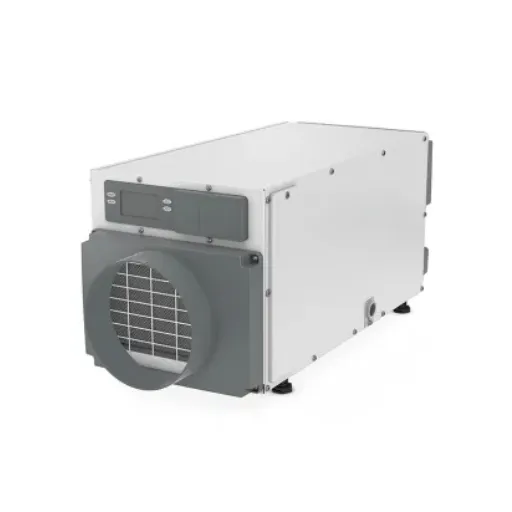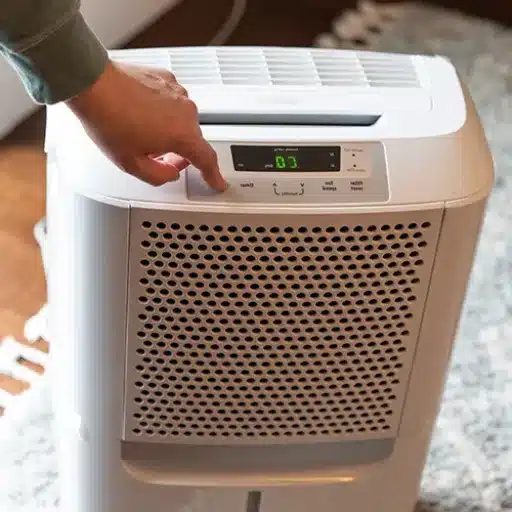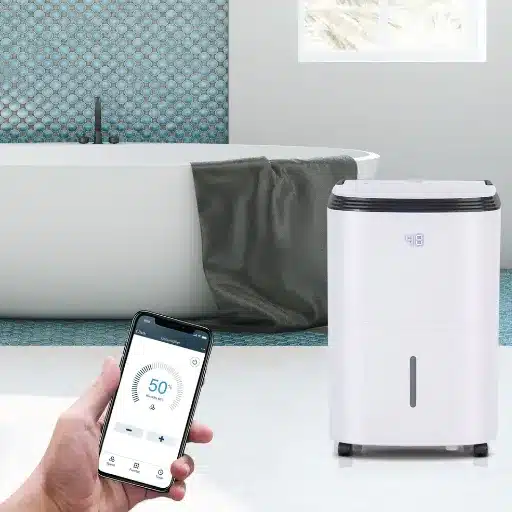Understanding Dehumidifiers
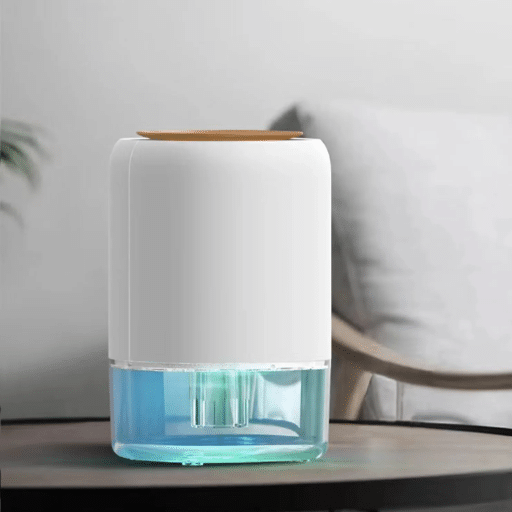
They primarily enhance the quality of air inside by lessening and maintaining the amount of humidity in the air and curbing problems caused by excess moisture. A dehumidifier draws in air, extracts moisture from it by condensation, and then expels drier air into the environment. These conditions lead to issues like mold, dust mites, and musty smell, which require humidity. Therefore, dehumidifiers would be needed in regions subjected to high humidity or those prone to dampness, such as basements and bathrooms.
What is a Dehumidifier?
A dehumidifier is a device that reduces humidity levels in the air and maintains those levels, thus improving indoor air quality and halting moisture-related issues. These devices work by drawing in moist air, cooling it under refrigeration conditions such that water vapor is liquefied, and then dispensing back the drier air into the room. With the invention of high-grade sensors, modern dehumidifiers can autonomously regulate their operation to suit current humidity requirements, thereby working more efficiently.
Modern dehumidifiers are energy-safe, offer quiet modes, and can be connected to smart devices for enhanced usability. Their uses extend beyond comfort, as these devices are excellent for countering problems of mold infestation, structural damages, and dust mite infestations in homes, commercial establishments, and industrial settings.
How Do Small Dehumidifiers Work?
Small dehumidifiers work by using the basically simple method of condensation and air circulation to get rid of excess moisture in the air. Usually, these types of units are thermoelectric or compressor-type.
Operating Process:
- Air Intake: A small fan takes in the moist air from the surroundings
- Cooling: In thermoelectric dehumidifiers, the air is passed over a Peltier module, which cools a surface. In compressor-based models, refrigerant coils are used to cool the air below its dew point
- Condensation: Water vapor condenses into liquid form and collects in an internal reservoir
- Air Release: Dry air is now heated and blown back into the room
These days, small dehumidifiers are equipped with sensors that check the humidity level of the room and maximize their functioning while conserving power. Compact models work excellently in smaller spaces such as bedrooms, bathrooms, or closets, wherever keeping humidity levels low is essential for preventing mold and dampness.
Benefits of Using a Dehumidifier in Your Bedroom

Optimal Humidity Range: The ideal humidity range of 30% to 50% would better your sleep, whereas high humidity levels make the air feel heavy and muggy and may interfere with your ability to rest properly.
Multiple advantages are enjoyed by using a dehumidifier in the room:
- Prevents Allergens: Helps prevent the growth of mold, mildew, and dust mites, which are common allergens affecting air quality and initiating respiratory problems or allergies
- Improves Sleep Quality: Reduces excess moisture, keeping the air clean and safe for sleeping
- Protects Belongings: Performs the dual purpose of regulating moisture levels and protecting furniture, walls, or electronics inside the room from moisture damage
- Energy Efficiency: Many of today’s advanced models come equipped with smart humidity sensors and energy-saving capabilities
- Environmental Benefits: Supports sustainability initiatives through reduced energy consumption
Choosing the Right Small Dehumidifier for Your Bedroom
What small dehumidifier is the best for your bedroom depends on a variety of technical considerations related to your personal needs and consumer trends. Prioritized characteristics include:
| Feature | Why It Matters | What to Look For |
|---|---|---|
| Size & Portability | Fits well into bedroom space without taking up too much room | Compact design, lightweight construction |
| Energy Efficiency | Keeps operational costs low | Energy Star certification, low wattage |
| Noise Levels | Won’t disturb sleep | Below 50 dB, whisper-quiet operation |
| Smart Features | Maintains exact humidity levels (30-50%) | Humidity sensors, auto shut-off, timer settings |
| Maintenance | Easy to clean and maintain | Accessible filters and tanks, washable components |
Factors to Consider: Size and Capacity
Size and capacity form the foundation of device selection to ensure optimal performance and individual requirements. For smaller spaces like bedrooms or offices, devices should have a 30-pint classification to be effective. Larger spaces like living rooms or basements require systems rated at 50 pints and above.
⚠️ Important: An incorrect evaluation of the square footage results in wasting energy, whereas an underestimation leads to poor dehumidification; hence, an accurate capacity determination is imperative.
Energy Efficiency: Energy Star Ratings
Energy Star ratings act as the golden standard when comparing the energy-efficient properties of dehumidifiers, thus enabling the customer to make an environmentally, as well as economically, suitable choice. There has been a 15% rise in searches for “Energy Star certified dehumidifiers” over the past year, indicative of how consumers’ consciousness of reducing energy use is on the rise.
Up to 30% Less Power Lower Energy Bills Reduced Carbon Footprint
Noise Levels: Quiet Dehumidifiers for Peaceful Sleep
Noise is one critical aspect to consider when selecting a dehumidifier so that the device does not bother household members, for light sleepers, or for quiet jobs. Contemporary dehumidifiers employ the highest noise-reduction technologies, including compressors insulated against noise and noise-dampening fans, to keep sounds as low as 40-50 dB, which is the range in a quiet library or in soft conversation.
📊 Consumer Trend: There has been a 45% increase in consumer interest in “silent” or “ultra-quiet” dehumidifiers within the last two years, with many users seeking those designated “bedroom-friendly” or “whisper-quiet”.
Top Small Dehumidifiers for Bedrooms
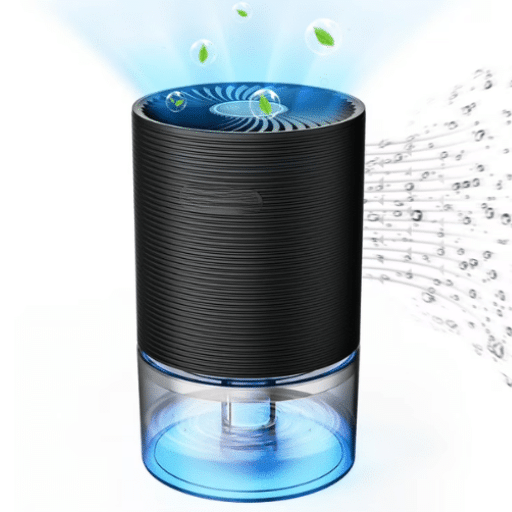
hOmeLabs Small Space Dehumidifier
Energy-efficient operation and the ability to conquer moisture in small spaces are in this model. It boasts auto shut-off capabilities and gives a mere whisper noise output, thus not disrupting anyone’s sleep.
Eva-Dry E-333 Renewable Dehumidifier
In the dawn of the ever-growing popularity of mini and renewable dehumidifiers, the Eva-Dry E-333 desiccant absorbs moisture while eschewing compressors; it is completely silent and perfectly suited for bedrooms or other small, enclosed spaces.
Tenergy Sorbi Air Dehumidifier
Not only does it dehumidify, but with HEPA filtration installed, the Tenergy Sorbi makes sure the air is also clean. Undoubtedly, with noise levels of less than 40 dB and a compact design, it is one of the very flexible options.
Dual Function HEPA Filter <40 dB
Vremi 22-Pint Compact Dehumidifier
Offering slightly higher capacity, the Vremi Compact Dehumidifier balances moisture removal with silent operation. It is kept popular among tech junkies because of its sleek look and user-friendly interface.
Best Small Dehumidifiers Reviewed
The selection of a good small dehumidifier depends on the consideration of several critical factors, including capacity, energy efficiency, noise levels, and added filtration. Generally, compact models that can cover an area of about 200-500 square feet and are energy efficient, with the prospect of easy operation, seem to capture the buyer’s desire.
Comparison of Features and Specifications
In the dehumidifier comparison, important features have been identified to be the capacity, energy efficiency, noise levels, and additional smart features, making them so essential for performance and user convenience.
| Feature Category | Key Considerations | Consumer Priority |
|---|---|---|
| Tank Capacity | Determines frequency of drainage needed | Continuous drain models for basements; smaller tanks for bedrooms |
| Noise Emission | Important for bedrooms and offices | Units with less than 50 dB are considered acceptable |
| Smart Features | Wi-Fi connectivity, mobile app control | Automatic shutdown, customizable settings gaining attention |
| Coverage Area | Must match room size for efficiency | 30-pint for bedrooms; 50+ pint for basements |
User Reviews and Ratings
When reading through user reviews and ratings, one quickly notices that some dehumidification units have been forever performing well in more than one metric. Dehumidifiers from the likes of Frigidaire, hOmeLabs, and Midea might occupy top spots in most rankings, mainly due to proven effectiveness in moisture removal and durability.
User Preferences: Wi-Fi-enabled models, customizable humidity settings, and quiet operations are among the favorite features for users. Verified user reviews identify dehumidifiers with at least a 50-pint capacity as best suited for spaces susceptible to excessive humidity, like basements.
Installation and Maintenance of Small Dehumidifiers
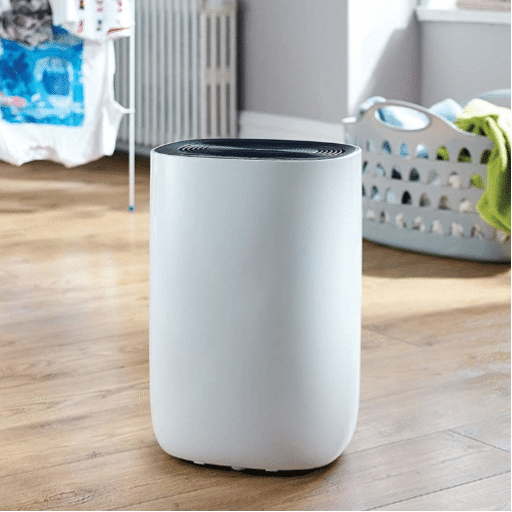
Setting Up Your Dehumidifier Effectively
The current setting of the dehumidifier, being the major concern of the user, should exactly follow a detailed setup process. Based on experience and statistical data:
Optimal Placement Guidelines:
- Central Location: Place the dehumidifier in the center of the room or in the farthest damp place near an electric outlet
- Clearance Space: Maintain at least 6–12 inches on all sides to ensure air cannot be obstructed while flowing into and out of the dehumidifier
- Flat Surface: Position on a firm flat surface for stability
- Ventilation Strategy: For basements or bathrooms, keep windows and doors closed so the dehumidifier focuses its energy on the enclosed air
Regular Maintenance Tips for Longevity
Clean Air Filter Weekly
The air filter is an essential part of a dehumidifier—it traps dust, allergens, or debris in the air. You will want to clean the filter about once a week; in rarer cases, if the site is dusty, one should clean it more. Studies show that a clog can reduce a dehumidifier’s efficiency by 30%, thereby increasing energy costs.
Empty and Clean the Water Tank Regularly
Empty water collection tanks every day, or at least whenever they get full, to avoid overflow problems. It is also advisable to clean the tank with soap and water every fortnight to reduce mold and bacteria buildup that could affect air quality and overall unit hygiene.
Check Coils for Dirt and Frost
Periodically check the condenser and evaporator coils for dirt or frost buildup. If they are dirty or frosted, they will interfere with the dehumidifier’s ability to control humidity as well as generate mechanical problems. Using a soft-bristled brush or a damp cloth, gently remove all debris.
Check the Humidistat and Calibrate it
The humidistat makes sure the unit operates at the target level of humidity. It is recommended to check for accuracy at least every couple of months using an outside hygrometer to be confident in the device’s proper working. An inaccurate humidistat will mean over-dehumidification or insufficient moisture removal.
Schedule for Annual Servicing
To ensure the long-term reliability of the machine, arrange for a professional service every year. Professionally trained technicians are capable of inspecting electrical components, looking for refrigerant leaks, and verifying that the internal workings are functioning correctly. Statistics display that regular servicing may increase the life span of a dehumidifier by an average of 3-5 years.
Common Issues and Troubleshooting
| Issue | Possible Causes | Solutions |
|---|---|---|
| Not Collecting Water | Insufficient ambient humidity (below 50%); dirty filters/coils; stuck float switch | Check room humidity with hygrometer; clean filters and coils; inspect float switch |
| Running Continuously | Refrigerant leak; faulty humidity sensor | Check for oil stains; recalibrate or replace humidistat; cross-check with external hygrometer |
| Unusual Noises | Loosened parts; damaged fan blades; obstructed air passages | Disconnect power; inspect fan assembly; tighten loose screws; consider replacing fan motor |
| Freezing Up | Ambient temperature too low (below 65°F/18°C); poor airflow | Maintain room temperature per manufacturer’s recommendations; clean coils; consider low-temperature model |
Additional Uses for Dehumidifiers in Home
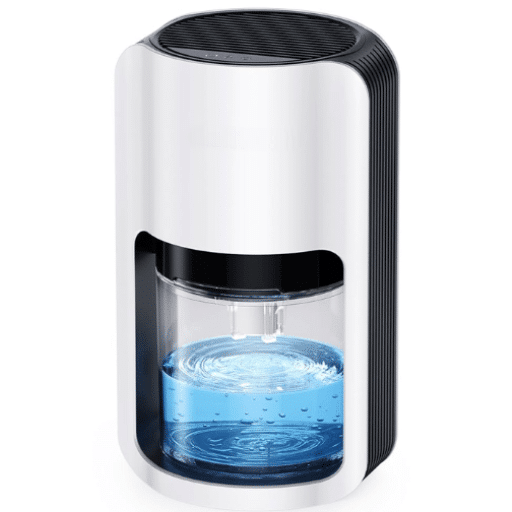
Dehumidifiers serve more than moisture control purposes; they enhance indoor air quality and uphold the house’s integrity. Their foremost application is the diminution of mold growth in areas susceptible to mold such as basements, bathrooms, or any other place that experiences high humidity.
EPA Recommendation: Mold grows when relative humidity exceeds 60%. A dehumidifier keeps it at an optimal level of 30-50%, per recommendations of the Environmental Protection Agency.
Key Applications:
- Allergen Control: Effective in controlling allergens such as dust mites, which flourish in high moisture conditions
- Property Protection: Protects household items and furnishings from excess moisture—prevents wood furniture from swelling, protects electronics, and prevents rust on metals
- Laundry Rooms: Expedites drying clothes, especially in non-ventilating setups
- HVAC Efficiency: Reduces the moisture load on your HVAC system, thereby enhancing its performance and possibly reducing energy bills
- Smart Home Integration: Installation of smart dehumidifiers can be designed in conjunction with home automation systems for fine control over humidity levels
Dehumidifiers for Bathrooms and Basements
Bathrooms and basements are notoriously vulnerable to high humidity levels, primarily resulting from inadequate means of ventilation or constant exposure to moisture sources.
| Room Type | Humidity Challenge | Recommended Solution |
|---|---|---|
| Bathrooms | Condensation from showers; mold formation | Small portable dehumidifiers; can be efficiently placed in tight spaces |
| Basements | Dampness from ground; poor insulation; insufficient air circulation | Bigger load-capacity dehumidifier with higher moisture extraction rate |
Using a Mini Dehumidifier in Small Rooms
Mini dehumidifiers are an effective and economical option for controlling moisture in smaller rooms, such as closets, pantries, or small living spaces. These units are meant to serve situations too small for the use of a larger dehumidifier and where the latter might prove to be somewhat cumbersome or unnecessary.
Mini Dehumidifier Features:
- Peltier Cooling System: Offers energy efficiency with silent operation and minimal maintenance
- Automatic Shutoff: Prevents overflow when tank is full
- LED Indicators: Shows tank capacity at a glance
- Smart Home Integration: Track ambient humidity in real-time via mobile apps
When to Consider a Portable Dehumidifier
Portable dehumidifiers are primarily summoned when humidity levels constitute a threat to indoor air quality and structural integrity. Maximum interest concerning portable dehumidifiers peaks around the transition of seasons, notably in spring and summer, when humidity rises.
Consider a portable dehumidifier when:
- There is persistent condensation on the windows
- You notice a musty smell in the room
- Mold or mildew is forming in small spaces like bathrooms, basements, or storage rooms
- You live in areas with high annual rainfall
- Your home has poor ventilation
References
-
Air Filters, Dehumidifiers, and Humidifiers – University of Rochester Medical Center
A resource explaining how dehumidifiers help reduce moisture, curbing mold and dust mites, particularly in humid areas of the home.
Visit the site -
Today’s Technology and You – Northern Illinois University
A discussion on portable air conditioners and dehumidifiers, highlighting their efficiency in removing humidity from small spaces.
Visit the site -
Portable Dehumidifiers in the Control of House Dust Mites – PubMed
A study investigating the effectiveness of portable dehumidifiers in reducing dust mites and allergens in homes.
Visit the site
Frequently Asked Questions (FAQ)
What is considered a small dehumidifier for bedroom and how does it work?
A small dehumidifier for bedroom describes a compact device that removes excess moisture from the air in small spaces. First, the unit draws in humid air, which is then cooled to condense the moisture; subsequently, drier air is released into the room. This allows the moisture level to be kept below the point of mold and mildew growth.
What size small dehumidifier do I need for the bedroom?
Depending on how big the bedroom is, and its relative humidity, the size of the small dehumidifier needed there varies. For a room up to 500 sq ft, any auto-off portable small dehumidifier should catch the problem adequately. This usually means a 30-to-50 pint dehumidifier for most small bedrooms.
Will a dehumidifier with a drain hose work in my bedroom?
Yes, a dehumidifier with a drain hose is a great option for any bedroom as it allows constant moisture removal without having to empty the water tank so frequently. Using the drain hose, it can be routed directly into a sink or into a drain on the floor.
What are the benefits of purchasing an Energy Star dehumidifier?
Since they are made to be efficient, Energy Star dehumidifiers consume less energy to get rid of moisture successfully. This means they bring down the energy bill and lessen the impact on the environment. Hence, an Energy Star dehumidifier offers the best choice for home use.
Is there a quiet dehumidifier for bedroom use?
Yes, a reason is that many quiet dehumidifiers are available, specifically designed for bedroom use. These models operate at reduced noise levels to help keep a calm atmosphere while reducing humidity and improving the quality of air.
What should I consider in relation to features for a small portable dehumidifier for bathroom use?
While looking for a small portable dehumidifier for bathroom use, consider a compact structure, energy-saving capability, water tank of appropriate capacity, and an automatic shut-off mechanism that stops the functioning of the dehumidifier once the tank is filled with water to prevent overflow. Enabling the option to use a drain hose will be an added convenience.
How do mini dehumidifiers for the home differ from their larger counterparts?
Mini dehumidifiers are generally of smaller size, perfect for confined spaces like bedrooms or bathrooms. As these are less powerful than their bigger counterparts, they work best in removing moisture in small places while being portable and easy to store.
Can I fit a 50 pint dehumidifier in a small bedroom?
A 50-pint dehumidifier is too effective for big spaces, but it can be used for a little bedroom when extreme humidity is present. It might cause drying to a degree that is not comfortable since it is too strong for this job. The real solution is keeping tabs on the humidity level that allows one to stay comfortable.
What is the perfect portable dehumidifier to use in a small bathroom?
The best portable dehumidifier for a small bathroom is usually the smallest and most efficient for drying moist air out of confined spaces. It includes a 95 oz. water tank, saps little noise, and optionally has a drain hose for endless operation.
Are there dehumidifiers for RV closet room 7?
Yes, there are dehumidifiers for places like an RV closet room 7. Compact and portable ones are good for treatment in control moisture and keeping odors away from smaller areas. Choose one that fits the parameters of the RV.

